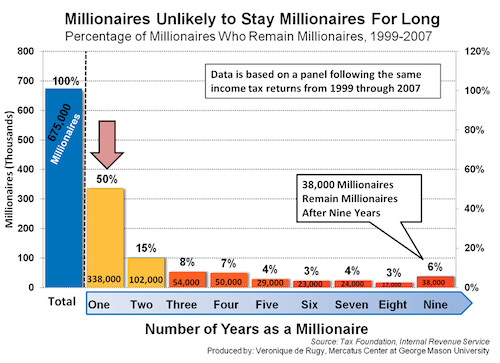- | Government Spending Government Spending
- | Data Visualizations Data Visualizations
- |
Millionaires Unlikely to Stay Millionaires for Long
In contrast to popular sentiments about the rich getting richer and poor getting poorer, this week’s chart shows that most millionaires are not millionaires for long.

In contrast to popular sentiments about the rich getting richer and poor getting poorer, this week’s chart shows that most millionaires are not millionaires for long. In other words, the majority of people in the top 0.17% of the income distribution (millionaires) also face substantial downward income mobility over time.
This week, Mercatus Center Research Fellow Veronique de Rugy examines the income dynamics of taxpayers with millionaire status using data calculated by the Tax Foundation that followed the same Internal Revenue Service (IRS) tax returns from 1999 through 2007. The data represent 675,000 taxpayers who were millionaires at some point during this period; this number serves as the benchmark for the percentages of millionaires who remain millionaires.
The data reveal that, after one year, roughly half of those who were millionaires at some point between 1999 and 2007 remain. After the second year, 15% or roughly 102,000 millionaires remain. This decreasing rate of remaining millionaires persists, and only about 6% or 38,000 millionaires remain after the ninth year.
One of the primary catalysts for the Occupy Wall Street movements is the idea that disparity between top earners and everybody else is widening. However, economic mobility and transiency of the millionaire income group is high. Many top earners are likely to lose their membership in the millionaire’s club.
Dr. de Rugy charts the share of income taxes paid by millionaires in a Mercatus Center publication.




